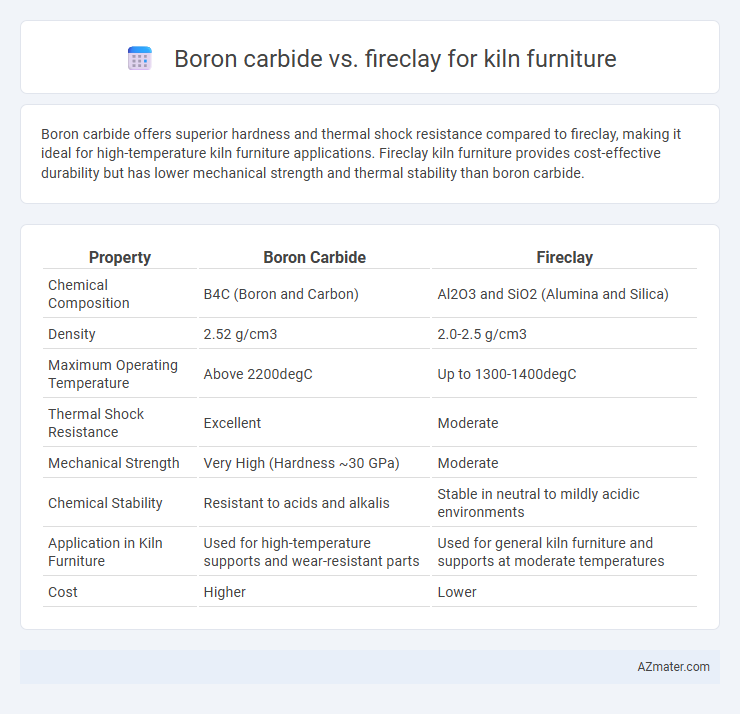Boron carbide offers superior hardness and thermal shock resistance compared to fireclay, making it ideal for high-temperature kiln furniture applications. Fireclay kiln furniture provides cost-effective durability but has lower mechanical strength and thermal stability than boron carbide.
Table of Comparison
| Property | Boron Carbide | Fireclay |
|---|---|---|
| Chemical Composition | B4C (Boron and Carbon) | Al2O3 and SiO2 (Alumina and Silica) |
| Density | 2.52 g/cm3 | 2.0-2.5 g/cm3 |
| Maximum Operating Temperature | Above 2200degC | Up to 1300-1400degC |
| Thermal Shock Resistance | Excellent | Moderate |
| Mechanical Strength | Very High (Hardness ~30 GPa) | Moderate |
| Chemical Stability | Resistant to acids and alkalis | Stable in neutral to mildly acidic environments |
| Application in Kiln Furniture | Used for high-temperature supports and wear-resistant parts | Used for general kiln furniture and supports at moderate temperatures |
| Cost | Higher | Lower |
Introduction to Kiln Furniture Materials
Boron carbide and fireclay represent two essential kiln furniture materials distinguished by their thermal and mechanical properties. Boron carbide boasts a high melting point of approximately 2763degC, exceptional hardness, and superior resistance to thermal shock, making it ideal for extreme temperature applications in advanced ceramics firing. Fireclay, composed mainly of alumina and silica, offers excellent thermal stability and cost-effectiveness at moderate temperatures, providing reliable support in traditional kiln environments.
Overview of Boron Carbide in Kiln Furniture
Boron carbide is a highly durable and wear-resistant material commonly used in kiln furniture due to its exceptional thermal stability and hardness. Its high melting point around 2763degC and low thermal expansion make it ideal for supporting ceramic wares in high-temperature kilns without deforming or cracking. Compared to fireclay, boron carbide offers superior resistance to thermal shock and mechanical abrasion, enhancing kiln furniture longevity and performance in industrial firing processes.
Fireclay: Composition and Uses in Kiln Furniture
Fireclay kiln furniture is composed primarily of refractory clays containing alumina and silica, offering excellent thermal stability and resistance to thermal shock. Its porous structure supports even heat distribution and prevents warping during high-temperature firing processes, making it ideal for supporting ceramic wares. Fireclay's affordability and durability make it a popular choice for kiln shelves, setters, and posts in both hobbyist and industrial ceramic firing.
Thermal Stability Comparison
Boron carbide exhibits superior thermal stability compared to fireclay, maintaining structural integrity at temperatures exceeding 2200degC, whereas fireclay typically withstands up to around 1600degC. The higher melting point and resistance to thermal shock make boron carbide ideal for high-temperature kiln furniture applications requiring prolonged exposure to extreme heat. Fireclay, while more affordable, tends to degrade faster under thermal cycling, limiting its use in advanced or industrial kiln environments.
Mechanical Strength and Durability
Boron carbide kiln furniture offers superior mechanical strength and exceptional wear resistance, making it ideal for high-temperature industrial applications requiring prolonged service life. Fireclay, while more economical and resistant to thermal shock, exhibits lower mechanical strength and tends to degrade faster under intense thermal cycling. Boron carbide's dense microstructure and chemical stability significantly enhance durability compared to the more porous and less robust fireclay materials used in kiln furniture.
Resistance to Chemical Attack
Boron carbide kiln furniture exhibits exceptional resistance to chemical attack, making it highly durable in harsh kiln environments with aggressive slags and fluxes. Fireclay, while more affordable, is prone to corrosion and degradation when exposed to acidic or basic compounds during high-temperature firing. The superior chemical inertness of boron carbide ensures longer service life and reduced contamination risks in ceramics production.
Weight and Handling Considerations
Boron carbide kiln furniture is significantly lighter than fireclay alternatives, reducing overall load and easing manipulation during kiln setup and rearrangement. Fireclay pieces tend to be heavier and more cumbersome, which can increase handling time and worker fatigue, especially in larger kiln operations. The lightweight nature of boron carbide supports enhances efficiency by enabling quicker changes and minimizing strain on personnel.
Cost Analysis: Boron Carbide vs Fireclay
Boron carbide kiln furniture typically incurs higher initial costs due to its superior hardness, wear resistance, and longer lifespan compared to fireclay counterparts. Fireclay offers a more economical upfront price but may require frequent replacement or maintenance, increasing long-term expenses. A comprehensive cost analysis must factor in the total cost of ownership, balancing boron carbide's durability against fireclay's affordability for optimal kiln furniture investment.
Longevity and Maintenance Requirements
Boron carbide kiln furniture exhibits exceptional longevity due to its high hardness and resistance to thermal shock, significantly reducing the frequency of replacements in industrial kilns. Fireclay, while more economical, requires more frequent maintenance because it is prone to chipping and wear under high-temperature cycling. The superior durability of boron carbide minimizes downtime and lowers long-term operational costs compared to fireclay options.
Best Applications and Recommendations
Boron carbide excels in kiln furniture applications requiring exceptional hardness, high thermal conductivity, and resistance to thermal shock, making it ideal for glass and ceramic firing processes where precision and durability are critical. Fireclay, with its lower cost and good thermal stability, suits less demanding applications such as pottery and low-temperature firings where moderate strength and insulation are sufficient. For high-performance industrial kilns, boron carbide is recommended for maximizing longevity and product quality, while fireclay remains a cost-effective choice for general-purpose kiln supports.

Infographic: Boron carbide vs Fireclay for Kiln Furniture
 azmater.com
azmater.com